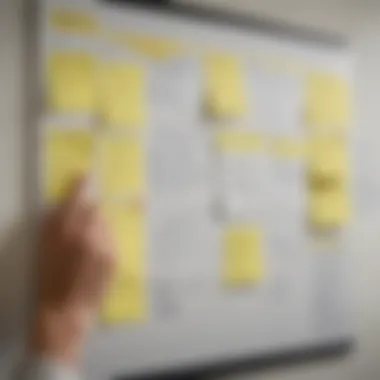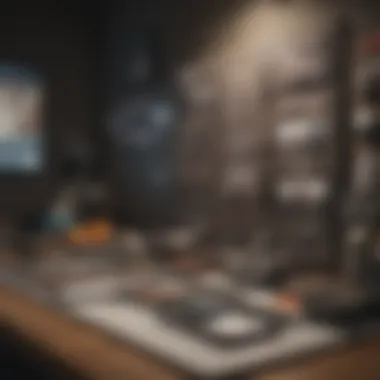Unlocking Creativity: A Complete Guide to Crafting an Effective Idea Board


Research Overview
When delving into the realm of creating an effective idea board, it is important to understand the intricacies involved in harnessing the power of this tool. An idea board serves as a catalyst for organizing thoughts, sparking creativity, and streamlining the ideation process. This comprehensive guide aims to walk you through every aspect of creating an idea board, from selecting the right materials to structuring it in a way that maximizes its effectiveness.
Health Implications
While the concept of an idea board may not seem directly tied to health, its impact on mental well-being and productivity cannot be overlooked. By utilizing an idea board to declutter and visualize thoughts, individuals can experience reduced stress levels, enhanced creativity, and improved mental clarity. The benefits of effectively utilizing an idea board extend beyond mere organization to positively influencing one's overall well-being.
Well-being Strategies
To optimize the benefits of an idea board, practical tips and strategies are essential. From allocating dedicated time for ideation to incorporating different visual elements, there are various methods to enhance the effectiveness of your idea board. Implementing positive changes in your approach to ideation and creativity can significantly contribute to a more streamlined thought process and increased productivity.
Expert Insights
Expert opinions play a crucial role in shedding light on the efficacy of idea boards in fostering creativity. By analyzing the insights of experts in creativity, productivity, and cognitive psychology, we can gain a deeper understanding of how idea boards can be leveraged to unlock creative potential. Engaging in a Q&A session with a relevant expert can provide invaluable perspectives on leveraging idea boards effectively.
Introduction
In the realm of organization and creativity, the idea board stands as a beacon of innovation and structure. This foundational piece serves as a dynamic platform for thought organization and idea cultivation – a testament to the power of visual thinking in harnessing productivity and inspiration. At its core, the idea board transcends mere physicality; it becomes a reflection of one's mental landscape, a canvas where thoughts converge and ideas blossom into actionable insights. As we embark on this comprehensive guide to creating an effective idea board, we delve into the essence of clarity, creativity, and efficiency that this tool embodies.
Understanding the Purpose of an Idea Board
The journey of crafting an idea board commences with a profound exploration of its purpose and utility. Through the lens of clarity, individuals find solace in the ability of the idea board to unriddle the complexities of their thoughts. By visually mapping out concepts and ideas, one not only clarifies their internal dialogue but also unlocks new perspectives previously obscured by mental clutter. This clarity serves as the cornerstone for effective decision-making and strategy formulation.
Fostering Creativity and Innovation
Beyond its organizational functions, the idea board acts as a catalyst for creativity and innovation. It transforms stagnant ideas into dynamic visual representations, fueling the creative process with a tangible form. The act of curating diverse thoughts on a singular platform sparks new connections and novel insights, nurturing a fertile ground for innovation to flourish. By embracing the power of visual stimuli, individuals transcend conventional thinking patterns, embracing a realm where creativity knows no bounds.


Boosting Productivity and Organization
In the realm of productivity and organization, the idea board emerges as a guiding light, illuminating a path towards efficiency and coherence. By categorizing ideas, setting priorities, and visualizing tasks, individuals streamline their workflow and optimize their output. Through the harmonious blend of structure and creativity, the idea board becomes a sanctuary of focused productivity, where ideas transition seamlessly into actionable plans. This synergy between creativity and organization propels individuals towards their goals with unwavering precision and clarity.
Understanding the Purpose of an Idea Board
In this section, we delve into the crucial aspect of understanding the purpose of an idea board, which serves as the foundation for effective utilization. An idea board acts as a visual representation of one's thoughts and concepts, aiding in clarification, inspiration, and organization. By comprehending the significance of the idea board, individuals can harness its full potential to enhance their creative processes and productivity.
Clarifying Your Thoughts and Ideas
Within the realm of idea boards, the process of clarifying thoughts and ideas is paramount. This involves translating abstract concepts into tangible visual representations, enabling individuals to conceptualize and refine their ideas with clarity. By articulating thoughts on the idea board, individuals can gain a deeper understanding of their projects, goals, and aspirations, fostering a structured approach to ideation.
Fostering Creativity and Innovation
The concept of fostering creativity and innovation through idea boards centers on the idea of visual stimulation. By having a dedicated space for idea generation and exploration, individuals are encouraged to think outside the box, experiment with new concepts, and visualize innovative solutions. The idea board serves as a catalyst for creativity, inspiring individuals to break free from conventional thinking patterns and explore novel perspectives.
Boosting Productivity and Organization
Productivity and organization are essential components of a successful idea board strategy. By utilizing the idea board as a central repository for thoughts and projects, individuals can streamline their workflow, track progress, and maintain focus on their objectives. The structured nature of an idea board facilitates efficient organization, enabling individuals to prioritize tasks, set goals, and enhance overall productivity.
Materials Needed for Creating an Idea Board
In the realm of crafting an effective idea board, the materials used play a pivotal role in the board's functionality and longevity. Selecting the appropriate materials sets the foundation for a successful idea board creation process. The right materials not only enhance the visual appeal of the board but also contribute significantly to its durability and usability. When considering materials for your idea board, aspects such as quality, size, and compatibility should be taken into account. Opting for high-quality materials ensures that your board can withstand the test of time, allowing you to securely pin or clip your ideas without wear and tear affecting the board's integrity. Moreover, the size of the board should align with the amount of space you have available and the volume of ideas you intend to display. A board that is too small may limit your creativity and restrict the number of ideas you can showcase effectively. Conversely, a board that is too large may consume excessive space and become unwieldy to manage. Compatibility with pins or clips is another essential consideration when choosing materials. Ensuring that the board surface is conducive to securing pins or clips firmly in place helps prevent ideas from falling off or getting damaged. By investing time and thought into selecting the right materials for your idea board, you pave the way for a seamless and productive ideation process.
Choosing the Right Board
When delving into the realm of idea board creation, one of the fundamental decisions you'll face pertains to selecting the right board. The choice of board sets the stage for how your ideas will be organized and displayed. There is a plethora of options available, ranging from traditional cork boards to sleek magnetic boards and innovative whiteboards. Each type of board offers unique advantages and caters to different preferences and requirements. For instance, a cork board provides a classic and tactile surface that allows for convenient pinning of ideas, making it ideal for those who prefer a hands-on approach to idea organization. On the other hand, magnetic boards offer a modern and versatile canvas for displaying ideas using magnets, enabling easy rearrangement and customization. Whiteboards, known for their versatility and erasability, are excellent for individuals who prefer a sleek and easily modifiable platform for brainstorming and idea visualization. The choice of the board should align with your working style, the nature of your ideas, and the overall aesthetic you wish to achieve. By selecting a board that resonates with your preferences and workflow, you set the stage for a productive and inspiring ideation experience.
Selecting Suitable Pins or Clips


An often-overlooked yet crucial component of creating an idea board is selecting suitable pins or clips to secure your ideas in place. The right pins or clips not only add a functional element to your board but also contribute to its visual appeal. When choosing pins or clips, factors such as material, size, and grip strength should be taken into consideration. Opting for durable pins or clips ensures the longevity of your ideas on the board, preventing them from falling or getting dislodged over time. Additionally, choosing pins or clips with a secure grip helps maintain the integrity of your ideas, preventing them from getting damaged or misplaced. The size of the pins or clips should also align with the thickness of the board to ensure a snug fit that holds your ideas firmly in place. Moreover, considering the aesthetic appeal of the pins or clips can enhance the overall look of your idea board, adding a touch of creativity and personalization to the display. By meticulously selecting pins or clips that meet both functional and visual criteria, you elevate the visual impact and usability of your idea board, creating a cohesive and engaging display.
Gathering Essential Supplies
In the process of setting up your idea board, gathering essential supplies is a crucial step that sets the stage for successful ideation and organization. Essential supplies encompass a range of items, including markers, sticky notes, push pins, adhesive tapes, and rulers, among others. These supplies not only aid in creatively presenting your ideas but also facilitate efficient organization and customization of your board. Markers serve as versatile tools for visually categorizing and labeling sections on your board, making it easier to navigate and understand the content displayed. Sticky notes are invaluable for jotting down quick ideas or making temporary notes that can be easily rearranged or removed as needed. Push pins offer a classic and secure method for attaching paper-based ideas to the board, ensuring they remain intact and visible. Adhesive tapes provide a flexible solution for attaching lightweight items or creating temporary dividers on the board. Rulers play a crucial role in maintaining alignment and precision when arranging ideas or creating visual schemes. By gathering these essential supplies, you equip yourself with the necessary tools to maximize the functionality and creativity of your idea board, fostering a more organized and visually appealing ideation process.
Setting Up Your Idea Board
In the realm of idea board creation, Setting Up Your Idea Board stands out as a pivotal stage that can either make or break the effectiveness of your board. Establishing your idea board correctly from the onset is essential in ensuring that it serves its purpose optimally. This section delves into the crucial aspects of this phase, highlighting the significance of thoughtful planning and meticulous execution. By meticulously setting up your idea board, you are laying the foundation for a structured and inspiring space where creativity and organization can flourish. Considering factors such as the layout, accessibility, and visual appeal during this stage can significantly impact the usability and impact of your idea board. Furthermore, setting up your idea board in a strategic and deliberate manner can enhance its functionality as a tool for brainstorming, planning, and innovation.
Creating Sections or Categories
As you begin the process of structuring your idea board, one key aspect to focus on is Creating Sections or Categories. Dividing your board into distinct sections based on either topics or projects can streamline the organization of your ideas and thoughts. By categorizing your content, you enhance the clarity and accessibility of the information displayed on the board. Additionally, having well-defined sections allows for easier navigation and reference, enabling you to locate specific ideas promptly. Ensure that the categories you create are logical and resonate with the purpose of your idea board, making it easier for you and others to contribute and retrieve relevant information efficiently.
Organizing Ideas Effectively
Once you have established sections or categories on your idea board, the next step is Organizing Ideas Effectively within each segment. Effective organization involves arranging your ideas in a structured and coherent manner that facilitates comprehension and analysis. Consider utilizing techniques such as color-coding, chronological ordering, or thematic clustering to arrange your thoughts meaningfully. This structured approach not only aids in visual appeal but also enhances the functionality of your idea board as a practical tool for idea generation and development. Proper organization contributes to a seamless workflow, enabling you to explore connections between different concepts and cultivate creativity.
Adding Visual Elements for Inspiration
To elevate the creative ambiance of your idea board, incorporating Visual Elements for Inspiration is paramount. Visual stimuli play a vital role in sparking creativity and stimulating innovative thinking. By integrating images, illustrations, quotes, or mind maps onto your idea board, you can create a visually engaging environment that captivates and motivates. Visual elements not only enhance the aesthetic appeal of the board but also serve as triggers for fresh ideas and perspectives. Embracing visual inspiration fosters a dynamic and stimulating atmosphere that fuels imagination and encourages active participation in idea generation and exploration.
Utilizing Your Idea Board
In this comprehensive guide to Creating an Effective Idea Board, the section on Utilizing Your Idea Board holds paramount significance. It serves as the linchpin that transforms a mere collection of notes and visuals into a dynamic hub of productivity and innovation. By understanding how to effectively utilize an idea board, individuals can harness its full potential to streamline ideation processes and drive meaningful outcomes. The crux of this topic lies in leveraging the board as more than just a passive display - it becomes a proactive tool for organizing thoughts, making decisions, and fostering collaboration.
Regularly Updating and Refreshing Content
Regularly Updating amassing is an essential practice when it comes to maintaining the relevance and utility of your idea board. As new ideas emerge and priorities shift, it is imperative to ensure that the board reflects the most current information. By frequently refreshing the content on the board, individuals can prevent stagnation and keep the ideas flowing. This not only fosters a sense of dynamism but also encourages continuous engagement with the board, ensuring that it remains a vibrant source of inspiration and innovation.


Using the Board as a Decision-Making Tool
The concept of Using the Board as a Decision-Making Tool underscores the practicality and versatility of an idea board. By leveraging the visual representation of ideas, individuals can distill complex information into tangible insights that facilitate decision-making. Whether weighing different options, prioritizing tasks, or strategizing future endeavors, the idea board serves as a visual aid that enhances clarity and promotes informed choices. This multifaceted approach transforms the board from a mere brainstorming tool into a strategic partner in the decision-making process.
Sharing and Collaborating on Ideas
Sharing and Collaborating on Ideas open doors to a realm of synergy and collective wisdom. By involving others in the ideation process, individuals can tap into diverse perspectives, expansive knowledge, and collaborative energies. Whether in a professional setting or a creative endeavor, sharing ideas on the board fosters a culture of openness and teamwork. Collaborative brainstorming not only enriches the pool of ideas but also cultivates a sense of ownership and camaraderie among contributors, leading to enhanced creativity and collective achievements.
Tips for Maximizing the Effectiveness of Your Idea Board
Creating an effective idea board goes beyond just putting up random thoughts and visuals. To truly harness the power of your idea board, it is crucial to implement strategies that enhance its usability and impact. By focusing on these 'Tips for Maximizing the Effectiveness of Your Idea Board', you can elevate it from a mere display to a dynamic tool that drives your creative process.
Keep It Visible and Easily Accessible
Visibility and accessibility are the cornerstones of a successful idea board. Placing your board in a prominent location where you frequent ensures that it remains in your line of sight, acting as a constant prompt for new ideas and inspiration. Whether it's in your workspace, a home office, or a communal area, having your idea board easily accessible encourages frequent interactions and updates.
Experiment with Different Layouts and Formats
Diversity in layout and format can breathe new life into your idea board. Embrace experimentation by trying out various arrangements, such as chronological timelines, mind maps, or thematic clusters. Different layouts can stimulate different thought processes and showcase your ideas from fresh perspectives, sparking novel connections and insights.
Combine Digital and Physical Elements for Hybrid Boards
In this digital age, integrating digital and physical elements into your idea board can amplify its versatility and functionality. By blending printed materials, sketches, and digital images or notes, you create a hybrid board that combines the tactile satisfaction of analog tools with the convenience of digital resources. This fusion offers the best of both worlds, allowing for seamless transitions between brainstorming and digital organization.
Conclusion
In the realm of idea generation and organization, the Conclusion serves as the pivotal endpoint of this comprehensive guide on Creating an Effective Idea Board. Far from being a mere afterthought, the Conclusion encapsulates the fundamental essence of why idea boards are indispensable tools for individuals seeking to streamline their ideation process. By delving into the strategic importance of Conclusions, we illuminate how summarizing, synthesizing, and distilling information can profoundly impact one's creative output and organizational acumen. In this dynamic exploration, we unpack the myriad benefits that an effective Conclusion brings to the forefront.
One of the key aspects underscored within this Conclusion is the power of encapsulating salient points and key takeaways from the guide on idea board creation. By distilling complex information into digestible snippets, the Conclusion acts as a compass, guiding readers towards a comprehensive understanding of the discussed concepts. This summarization not only reinforces learning but also aids in memory retention and application of acquired knowledge.
Moreover, the Conclusion functions as an evaluative tool, prompting individuals to reflect on the relevance and applicability of the shared insights within their own contexts. The interpretative nature of a well-crafted Conclusion allows for critical analysis and self-assessment, fostering a deep connection between theory and practice in the realm of idea board utilization.
Furthermore, drawing attention to the potential considerations surrounding Conclusion highlights the necessity for intentional closure in any creative or organizational endeavor. Just as the opening sets the stage, the Conclusion provides a sense of closure and resolution, signaling the culmination of an idea board's purposeful journey. It compels individuals to not only extract value from the presented information but also to contemplate the actionable steps they can implement to enhance their idea board strategies.
In essence, the Conclusion stands as a testament to the holistic nature of idea board creation, underscoring its significance beyond a mere physical or digital repository of ideas. By imbuing the board with intelligence, introspection, and direction through a robust Conclusion, individuals can elevate their creative processes, enhance productivity, and embark on a journey of refined ideation and organizational mastery.



